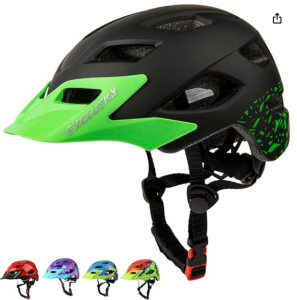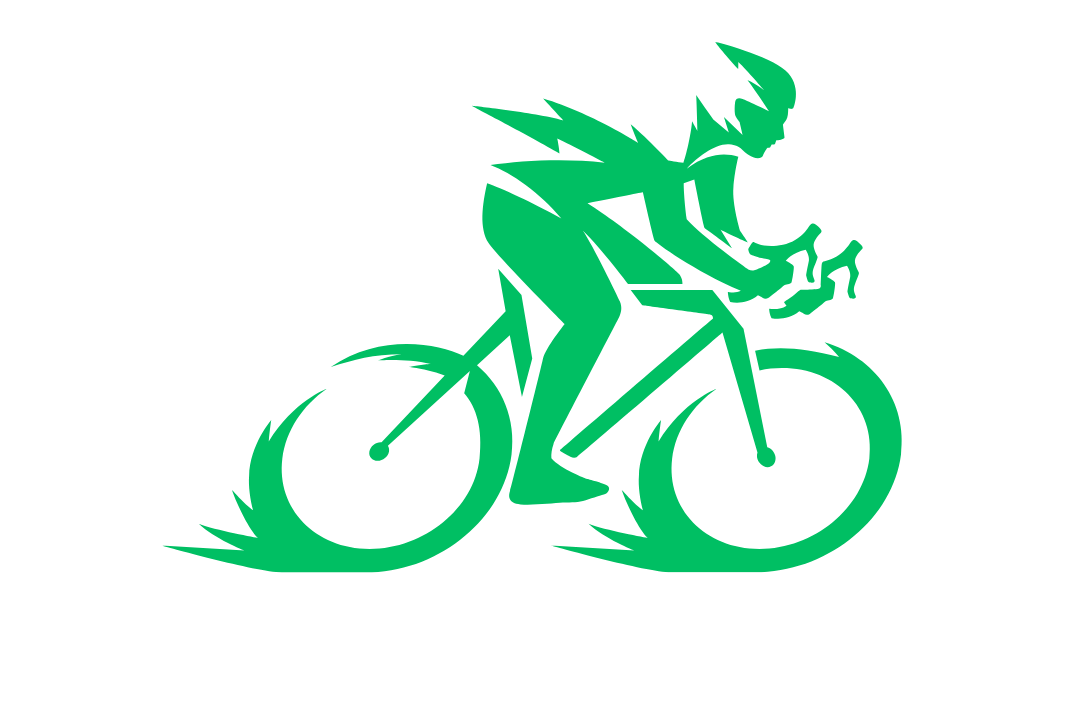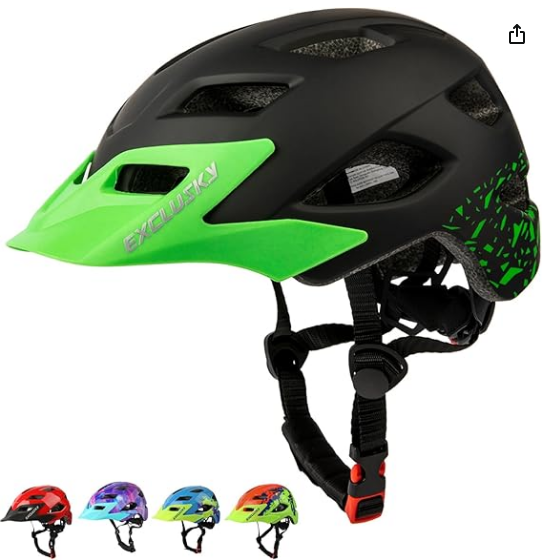Kids Bike Helmet: Essential Details
A kids’ bike helmet is a crucial safety accessory designed to protect children while they ride bicycles, scooters, or skateboards. Here are the key details:

Please Check the Price on Amazon
1. Safety Standards
A good kids’ bike helmet should meet safety certifications such as:
-
CPSC (Consumer Product Safety Commission – USA)
-
EN 1078 (European Standard)
-
ASTM (American Society for Testing and Materials)
These certifications ensure the helmet provides adequate impact protection.
2. Size & Fit
-
Helmets come in different sizes, typically measured in centimeters (cm) around the child’s head.
-
Adjustable straps and a rear dial fit system help achieve a snug and comfortable fit.
-
Common sizes:
-
XS (Extra Small) – 44-48 cm
-
S (Small) – 48-52 cm
-
M (Medium) – 52-56 cm
-
3. Construction & Materials
-
Outer Shell: Made of durable polycarbonate or ABS plastic for impact resistance.
-
Inner Layer: EPS (Expanded Polystyrene) foam absorbs shock from falls.
-
Padding: Soft, moisture-wicking, and removable pads enhance comfort and hygiene.
4. Ventilation
-
Multiple air vents keep kids cool during rides, preventing overheating.
-
Mesh-covered vents protect from insects while allowing airflow.
5. Adjustable Straps & Buckle
-
A secure chin strap with a quick-release buckle ensures a snug fit.
-
Side strap dividers help position the helmet correctly.
6. Visor & Reflective Elements
-
Some helmets have a detachable visor to shield from sun and rain.
-
Reflective stickers or LED lights enhance visibility in low-light conditions.
7. Design & Colors
-
Bright colors and fun patterns appeal to kids.
-
Themes may include cartoon characters, animals, and sports designs.
8. Multi-Sport Use
-
Some helmets are designed for cycling, skateboarding, and rollerblading.
-
Look for “multi-sport” certification if using for multiple activities.
9. Weight & Comfort
-
Lightweight designs (200g-300g) reduce strain on the child’s neck.
-
A soft interior lining enhances comfort.
10. Maintenance & Lifespan
-
Replace after a crash or if the helmet shows signs of damage.
-
Clean with mild soap and water; avoid harsh chemicals.
-
Check for wear and tear periodically.
A well-fitted, high-quality kids’ bike helmet ensures safety and encourages children to enjoy outdoor activities with confidence.
Required Qualities of a Kids’ Bike Helmet
A high-quality kids’ bike helmet should have the following essential qualities to ensure safety, comfort, and durability:
1. Certified Safety Standards
-
Must comply with recognized safety certifications:
-
CPSC (USA) – Consumer Product Safety Commission
-
EN 1078 (Europe) – Bicycle Helmet Standard
-
ASTM F1447 (USA) – Standard for Bicycle Helmets
-
-
These certifications confirm impact resistance and structural integrity.
2. Proper Fit & Adjustable Sizing
-
Available in different sizes (XS, S, M) with measurement in centimeters (cm).
-
Dial-adjustable fit system at the back for a snug and secure fit.
-
Adjustable chin straps with a secure buckle for a firm hold.
-
Soft padding inside for a comfortable and irritation-free experience.
3. Strong & Lightweight Construction
-
Outer Shell: Made from polycarbonate (PC) or ABS plastic for impact resistance.
-
Inner Layer: High-density EPS (Expanded Polystyrene) foam to absorb shock and reduce head injury.
-
Lightweight design (200-300g) to avoid neck strain.
4. Efficient Ventilation
-
Multiple air vents to keep the child’s head cool during rides.
-
Mesh-covered vents for protection from bugs and debris while ensuring airflow.
5. Comfortable & Washable Padding
-
Soft, sweat-absorbing padding for extra comfort.
-
Removable and washable padding for hygiene and long-term use.
6. Secure Chin Strap & Buckle System
-
Quick-release buckle for easy wearing and removal.
-
Side strap dividers for proper helmet positioning and stability.
7. Impact Absorption & Durability
-
Must withstand falls and absorb shocks effectively.
-
Should not crack or break easily with minor impacts.
8. Visibility & Safety Features
-
Bright colors & reflective stickers for better visibility in low light.
-
LED rear light option in some helmets for added safety.
9. Versatile & Multi-Sport Use
-
Suitable for cycling, skateboarding, rollerblading, and scootering.
-
If used for multiple sports, ensure the helmet has multi-sport certification.
10. UV & Weather Protection
-
A detachable visor to shield from the sun, rain, and dust.
-
UV-resistant outer shell for long-lasting durability.
11. Long Lifespan & Maintenance
-
Should last 3-5 years unless damaged in an accident.
-
Easy to clean with mild soap and water.
-
Regular inspection for cracks, loose parts, or worn-out straps.
Conclusion
A high-quality kids’ bike helmet should prioritize safety, comfort, durability, and adjustability to ensure maximum protection during cycling or other outdoor activities. Investing in a properly certified and well-fitted helmet helps prevent head injuries and encourages kids to ride with confidence.

